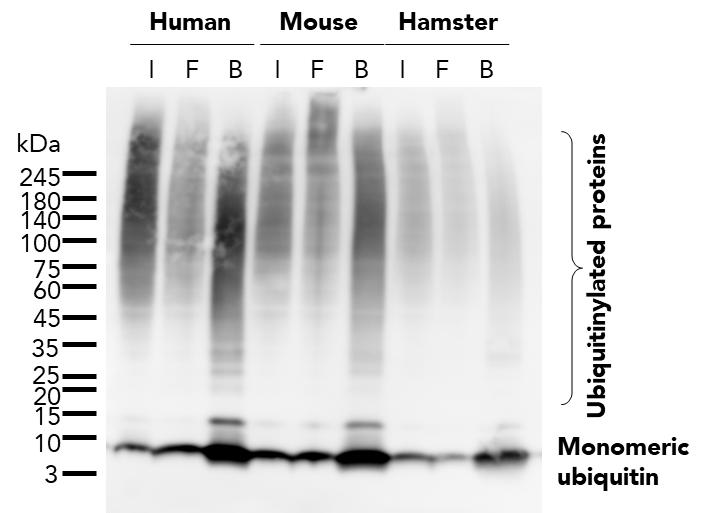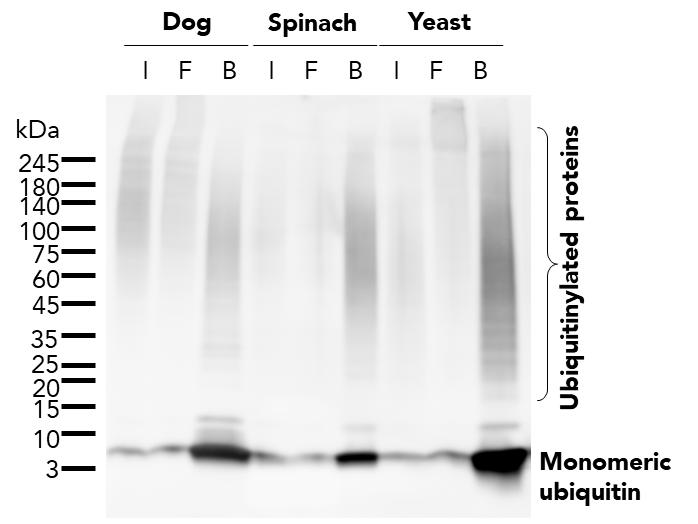Validation Data Gallery
Product Information
The ChromoTek Ubiquitin-Trap Magnetic Agarose consists of an anti-Ubiquitin Nanobody/VHH, which is coupled to magnetic agarose beads. It can be used for the immunoprecipitation of ubiquitin and ubiquitinylated proteins from mammalian, plant and yeast cell extracts.
| Description | Immunoprecipitation of ubiquitin and ubiquitinylated proteins with anti-Ubiquitin Nanobody conjugated to magnetic agarose beads • Fast, reliable & efficient one-step immunoprecipitation • Ready-to-use • No heavy & light antibody chains • Stable under harsh washing conditions • Suitable for downstream mass spec analysis • Works in samples from: mammals, plants, yeast, etc. |
| Applications | IP, CoIP |
| Specificity/Target | Binds to monomeric ubiquitin, ubiquitin chains, and ubiquitinylated proteins. Ubiquitin chains may be linked via lysines; linkages via lysines such as K11, K48 and K63 are compatible with binding by the Ubiquitin-Trap (further linkage types also likely to be compatible, but not tested). |
| Tested Reactivity | Human, Mouse, Hamster, Dog, Spinach, Yeast |
| Conjugate | Magnetic agarose beads; ~40 um (cross-linked 6% magnetic agarose beads) |
| Elution buffer | 2x SDS-sample buffer (Lammli) |
| Wash buffer compatibility | 2M NaCl, 5 mM DTT, 0 mM β-mercaptoethanol, 5 mM TCEP, 2% NP40, 2% Triton X-100, 0% SDS, 2-3 M Urea |
| Type | Nanobody |
| Class | Recombinant |
| Host | Camelid |
| Affinity | The KD for monomeric ubiquitin is 90 nM. The apparent affinity is even higher for ubiquitin chains due to avidity effects. |
| Compatibility with mass spectrometry | The Ubiquitin-Trap is optimized for on-bead digestion. For the application note, please click here: On-bead digest protocol for mass spectrometry |
| RRID | AB_2943578 |
| Storage Buffer | 20% ethanol |
| Storage Condition | Shipped at ambient temperature. Upon receipt store at +4°C. Stable for one year. DO not freeze! |
| Size | 25ul/reactions (eg:20rxns=500ul slurry) |
Documentation
| SDS |
|---|
| utma_SDS_Ubiquitin-Trap Magnetic Agarose (EN) |
| Datasheet |
|---|
| Ubiquitin-Trap Magnetic Agarose Datasheet |
Publications
| Application | Title |
|---|---|
bioRxiv A human papillomavirus 16 E2-TopBP1 dependent SIRT1-p300 acetylation switch regulates mitotic viral and human protein levels | |
Nat Commun OTUD6 deubiquitination of RPS7/eS7 on the free 40 S ribosome regulates global protein translation and stress |




